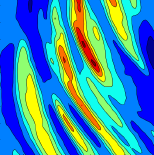Heart Rhythm 8:429-436, 2011
links
Paper doi:10.1016/j.hrthm.2010.11.020
Editorial comment doi:10.1016/j.hrthm.2010.12.020
abstract
Background: Acute atrial dilatation increases the susceptibility to atrial fibrillation (AF). It is, however, still to be determined by which mechanisms atrial stretch may contribute to initiation and perpetuation of AF.
Objective: Using a novel multi-scale model of atrial electromechanics and mechano-electrical feedback, the hypothesis was tested whether acute stretch increased vulnerability to AF by heterogeneous activation of stretch-activated channels (SACs).
Methods: The human atria were represented by a triangular mesh obtained from MRI data. Atrial trabecular bundle structure was incorporated by varying thickness of the atrial wall. Atrial membrane behavior was modeled by the Courtemanche-Ramirez-Nattel model, with the addition of a nonselective stretch-activated cation current (Isac). Mechanical behavior was modeled by a series elastic, a contractile, and a parallel elastic element in which contractile force was related to intracellular concentration of free calcium and sarcomere length.
Results: Acute atrial dilatation was simulated by increasing stretch throughout the atrial wall. Stimulation near the pulmonary vein ostia at an interval of 600 ms induced AF at overall stretch ratio 1.10. Initiation and perpetuation of AF in our model were related to an increased dispersion of effective refractory period, conduction slowing, and local conduction block, all related to heterogeneous activation of Isac. Upon local contraction, mechano-electrical coupling affects perpetuation of AF by temporarily changing local excitability.
Conclusions: During acute atrial dilatation, heterogeneous activation of Isac enhances initiation and can affect perpetuation of AF.

